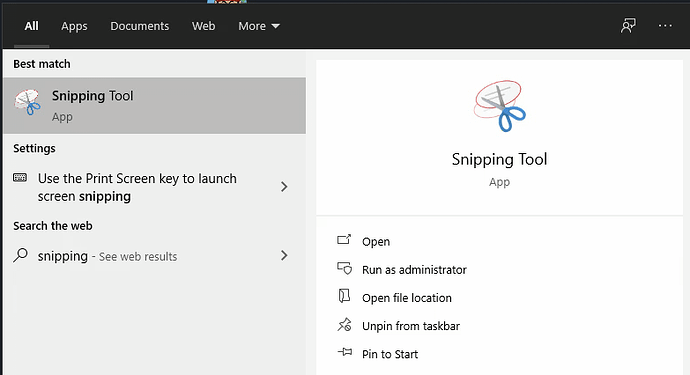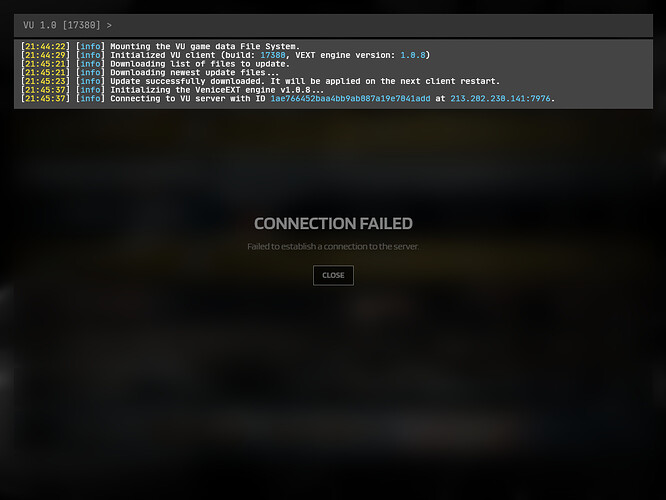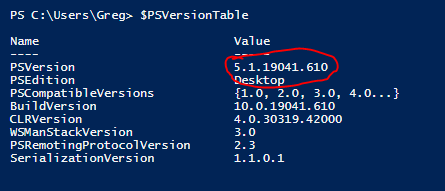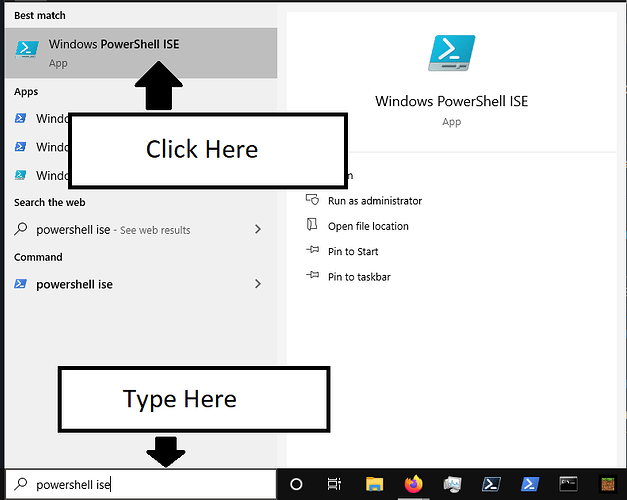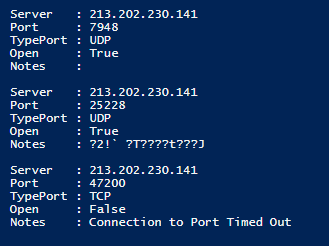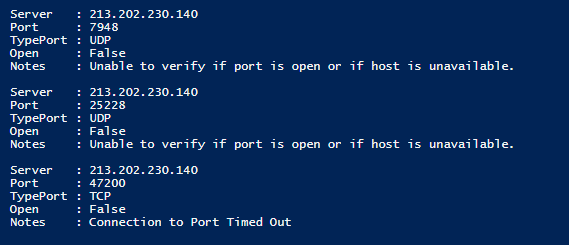To start, this will require PowerShell version 5.1 or higher. You can check the version of PowerShell that is installed by opening a PowerShell prompt and typing “$PSVersionTable”. The version shown here is 5.1.
Once you’ve verified the version is correct, then open PowerShell ISE.
Copy and paste this code into PowerShell ISE. Sorry about the lack of indenting; this forum is not code friendly.
# 1. Find a server in the Venice Unleashed Client
# 2. Connect to that server
# 3. Press the Backtick “`” or Tilda “~” key to show the console
# 4. Find the line that looks like this:
#
# [12:00:00] [info] Connecting to frostbite server at AAA.BBB.CCC.DDD:#####
#
# 5. Put AAA.BBB.CCC.DDD:##### into the line of code below
$VeniceUnleashedServer = “AAA.BBB.CCC.DDD:#####”;
$HarmonyPort = 7948;
$RconPort = 47200;
function Test-Port{
<#
.SYNOPSIS
Tests port on computer.
.DESCRIPTION
Tests port on computer.
.PARAMETER computer
Name of server to test the port connection on.
.PARAMETER port
Port to test
.PARAMETER tcp
Use tcp port
.PARAMETER udp
Use udp port
.PARAMETER UDPTimeOut
Sets a timeout for UDP port query. (In milliseconds, Default is 1000)
.PARAMETER TCPTimeOut
Sets a timeout for TCP port query. (In milliseconds, Default is 1000)
.NOTES
Name: Test-Port.ps1
Author: Boe Prox
DateCreated: 18Aug2010
List of Ports: Service Name and Transport Protocol Port Number Registry
To Do:
Add capability to run background jobs for each host to shorten the time to scan.
.LINK
https://boeprox.wordpress.org
.EXAMPLE
Test-Port -computer ‘server’ -port 80
Checks port 80 on server ‘server’ to see if it is listening
.EXAMPLE
‘server’ | Test-Port -port 80
Checks port 80 on server ‘server’ to see if it is listening
.EXAMPLE
Test-Port -computer @(“server1”,“server2”) -port 80
Checks port 80 on server1 and server2 to see if it is listening
.EXAMPLE
Test-Port -comp dc1 -port 17 -udp -UDPtimeout 10000
Server : dc1
Port : 17
TypePort : UDP
Open : True
Notes : "My spelling is Wobbly. It's good spelling but it Wobbles, and the letters
get in the wrong places." A. A. Milne (1882-1958)
Description
-----------
Queries port 17 (qotd) on the UDP port and returns whether port is open or not
.EXAMPLE
@(“server1”,“server2”) | Test-Port -port 80
Checks port 80 on server1 and server2 to see if it is listening
.EXAMPLE
(Get-Content hosts.txt) | Test-Port -port 80
Checks port 80 on servers in host file to see if it is listening
.EXAMPLE
Test-Port -computer (Get-Content hosts.txt) -port 80
Checks port 80 on servers in host file to see if it is listening
.EXAMPLE
Test-Port -computer (Get-Content hosts.txt) -port @(1..59)
Checks a range of ports from 1-59 on all servers in the hosts.txt file
#>
[cmdletbinding(
DefaultParameterSetName = ‘’,
ConfirmImpact = ‘low’
)]
Param(
[Parameter(
Mandatory = $True,
Position = 0,
ParameterSetName = ‘’,
ValueFromPipeline = $True)]
[array]$computer,
[Parameter(
Position = 1,
Mandatory = $True,
ParameterSetName = ‘’)]
[array]$port,
[Parameter(
Mandatory = $False,
ParameterSetName = ‘’)]
[int]$TCPtimeout=1000,
[Parameter(
Mandatory = $False,
ParameterSetName = ‘’)]
[int]$UDPtimeout=1000,
[Parameter(
Mandatory = $False,
ParameterSetName = ‘’)]
[switch]$TCP,
[Parameter(
Mandatory = $False,
ParameterSetName = ‘’)]
[switch]$UDP
)
Begin {
If (!$tcp -AND !$udp) {$tcp = $True}
#Typically you never do this, but in this case I felt it was for the benefit of the function
#as any errors will be noted in the output of the report
$ErrorActionPreference = “SilentlyContinue”
$report = @()
}
Process {
ForEach ($c in $computer) {
ForEach ($p in $port) {
If ($tcp) {
#Create temporary holder
$temp = “” | Select Server, Port, TypePort, Open, Notes
#Create object for connecting to port on computer
$tcpobject = new-Object system.Net.Sockets.TcpClient
#Connect to remote machine’s port
$connect = $tcpobject.BeginConnect($c,$p,$null,$null)
#Configure a timeout before quitting
$wait = $connect.AsyncWaitHandle.WaitOne($TCPtimeout,$false)
#If timeout
If(!$wait) {
#Close connection
$tcpobject.Close()
Write-Verbose “Connection Timeout”
#Build report
$temp.Server = $c
$temp.Port = $p
$temp.TypePort = “TCP”
$temp.Open = “False”
$temp.Notes = “Connection to Port Timed Out”
} Else {
$error.Clear()
$tcpobject.EndConnect($connect) | out-Null
#If error
If($error[0]){
#Begin making error more readable in report
[string]$string = ($error[0].exception).message
$message = (($string.split(“:”)[1]).replace(‘"’,“”)).TrimStart()
$failed = $true
}
#Close connection
$tcpobject.Close()
#If unable to query port to due failure
If($failed){
#Build report
$temp.Server = $c
$temp.Port = $p
$temp.TypePort = “TCP”
$temp.Open = “False”
$temp.Notes = “$message”
} Else{
#Build report
$temp.Server = $c
$temp.Port = $p
$temp.TypePort = “TCP”
$temp.Open = “True”
$temp.Notes = “”
}
}
#Reset failed value
$failed = $Null
#Merge temp array with report
$report += $temp
}
If ($udp) {
#Create temporary holder
$temp = “” | Select Server, Port, TypePort, Open, Notes
#Create object for connecting to port on computer
$udpobject = new-Object system.Net.Sockets.Udpclient
#Set a timeout on receiving message
$udpobject.client.ReceiveTimeout = $UDPTimeout
#Connect to remote machine’s port
Write-Verbose “Making UDP connection to remote server”
$udpobject.Connect(“$c”,$p)
#Sends a message to the host to which you have connected.
Write-Verbose “Sending message to remote host”
$a = new-object system.text.asciiencoding
$byte = $a.GetBytes(“$(Get-Date)”)
[void]$udpobject.Send($byte,$byte.length)
#IPEndPoint object will allow us to read datagrams sent from any source.
Write-Verbose “Creating remote endpoint”
$remoteendpoint = New-Object system.net.ipendpoint([system.net.ipaddress]::Any,0)
Try {
#Blocks until a message returns on this socket from a remote host.
Write-Verbose “Waiting for message return”
$receivebytes = $udpobject.Receive([ref]$remoteendpoint)
[string]$returndata = $a.GetString($receivebytes)
If ($returndata) {
Write-Verbose “Connection Successful”
#Build report
$temp.Server = $c
$temp.Port = $p
$temp.TypePort = “UDP”
$temp.Open = “True”
$temp.Notes = $returndata
$udpobject.close()
}
} Catch {
If ($Error[0].ToString() -match “\bRespond after a period of time\b”) {
#Close connection
$udpobject.Close()
#Make sure that the host is online and not a false positive that it is open
If (Test-Connection -comp $c -count 1 -quiet) {
Write-Verbose “Connection Open”
#Build report
$temp.Server = $c
$temp.Port = $p
$temp.TypePort = “UDP”
$temp.Open = “True”
$temp.Notes = “”
} Else {
<#
It is possible that the host is not online or that the host is online,
but ICMP is blocked by a firewall and this port is actually open.
#>
Write-Verbose “Host maybe unavailable”
#Build report
$temp.Server = $c
$temp.Port = $p
$temp.TypePort = “UDP”
$temp.Open = “False”
$temp.Notes = “Unable to verify if port is open or if host is unavailable.”
}
} ElseIf ($Error[0].ToString() -match “forcibly closed by the remote host” ) {
#Close connection
$udpobject.Close()
Write-Verbose “Connection Timeout”
#Build report
$temp.Server = $c
$temp.Port = $p
$temp.TypePort = “UDP”
$temp.Open = “False”
$temp.Notes = “Connection to Port Timed Out”
} Else {
$udpobject.close()
}
}
#Merge temp array with report
$report += $temp
}
}
}
}
End {
#Generate Report
$report
}
}
$VUServerIP = $VeniceUnleashedServer.split(‘:’)[0];
$FrostbitePort = $VeniceUnleashedServer.split(‘:’)[1];
$ErrorActionPreference = “Stop”;
Test-Port -comp $VUServerIP -port $HarmonyPort -udp -UDPtimeout 10000;
Test-Port -comp $VUServerIP -port $FrostbitePort -udp -UDPtimeout 10000;
Test-Port -comp $VUServerIP -port $RconPort -tcp;
Then open the Venice Unleashed client.
Find and connect to a server.
Press the Backtick “`” or Tilda “~” key to show the console.
Find the line that looks like this:
[12:00:00] [info] Connecting to frostbite server at AAA.BBB.CCC.DDD:#####
Put the IP address and port into the script on line 10, where $VeniceUnleashedServer is assigned a value.
Run the script and wait several seconds.
Here is an example of what you get when you scan a legitimate, working Venice Unleashed server:
Here is an example of what you get when you scan an IP that doesn’t host a Venice Unleashed server:
If you are behind a local, corporate, or country-wide firewall and try to scan a legitimate VU server, you might find that what is returned looks like the server doesn’t exist.
Follow these instructions and post screenshots of servers that you can AND cannot connect to. …and tell us which is which. 


